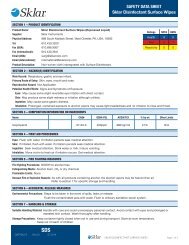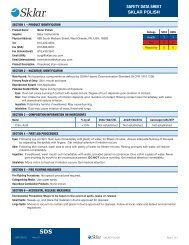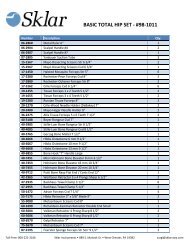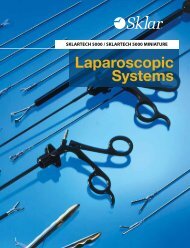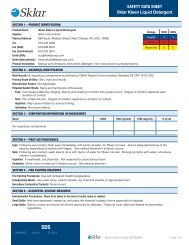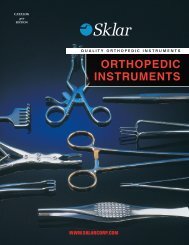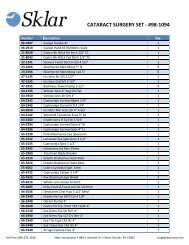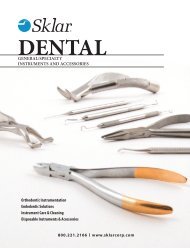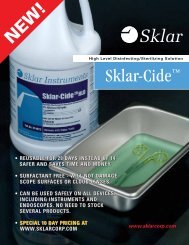- Page 2 and 3:
Table of ContentsSTERILE PROCEDUREK
- Page 4 and 5:
SklarALL-PURPOSE INSTRUMENT TRAYcas
- Page 6 and 7:
SklarGENERAL PURPOSE TRAYcase/25 96
- Page 8 and 9:
SklarBASIC SET UP TRAYcase/6 96-432
- Page 10 and 11:
SklarSINGLE BASIN TRAYcase/5 96-433
- Page 12 and 13:
SklarCIRCUMCISION TRAYcase/20 96-44
- Page 14 and 15:
SklarCIRCUMCISION TRAYcase/20 96-44
- Page 16 and 17:
SklarPERITONEAL DIALYSIS TRAYcase/3
- Page 19 and 20:
DRESSING CHANGE TRAYSDRESSING CHANG
- Page 21 and 22:
DRESSING CHANGE TRAYSDRESSING CHANG
- Page 23 and 24:
DRESSING CHANGE TRAYSDRESSING CHANG
- Page 25 and 26:
DRESSING CHANGE TRAYSDRESSING CHANG
- Page 27 and 28:
GENERAL SURGERY TRAYSGENERAL SURGER
- Page 29 and 30:
GENERAL SURGERY TRAYSTOTAL JOINT TR
- Page 31 and 32:
GENERAL SURGERY TRAYSLAPAROSCOPE CH
- Page 33 and 34:
INCISION AND DRAINAGE TRAYSINCISION
- Page 35 and 36:
IV START TRAYSIV START TRAYcase/100
- Page 37 and 38:
IV START TRAYSIV START TRAYcase/100
- Page 39 and 40:
LACERATION TRAYSLACERATION TRAYcase
- Page 41 and 42:
LACERATION TRAYSLACERATION TRAYSCRO
- Page 43 and 44:
WOUND CLOSURE TRAYSWOUND CLOSURE TR
- Page 45 and 46:
WOUND CLOSURE TRAYSWOUND CLOSURE TR
- Page 47 and 48:
OB/GYN PROCEDURE TRAYSNERVE BLOCK P
- Page 49 and 50:
OB/GYN PROCEDURE TRAYSLABOR AND DEL
- Page 51 and 52:
SUTURE REMOVAL TRAYSSUTURE REMOVAL
- Page 53 and 54:
SUTURE REMOVAL TRAYSPREMIUM SUTURE
- Page 55 and 56:
SUTURE REMOVAL TRAYSSUTURE REMOVAL
- Page 57 and 58:
SUTURE REMOVAL TRAYSCROSS REFERENCE
- Page 59 and 60:
TRACHEOSTOMY CARE TRAYSTRACHEOSTOMY
- Page 61 and 62:
TRACHEOSTOMY CARE TRAYSTRACHEOSTOMY
- Page 63 and 64:
ADMISSION TRAYSDELUXE ADMISSION TRA
- Page 65 and 66:
ADMISSION TRAYSECONOMY BABY CARE TR
- Page 67 and 68:
SKLAR BASIC SET-UP PACKSSklar Basic
- Page 69 and 70:
REINFORCEDBACK TABLECOVERSEQUIPMENT
- Page 71 and 72:
EQUIPMENT COVERSFluoroscopeCoversNo
- Page 73 and 74:
SklarEQUIPMENT COVERSMayo Stand Cov
- Page 75 and 76:
EQUIPMENT COVERSSklarBand Bagswith
- Page 77 and 78:
EQUIPMENT COVERSSklarMICROSCOPEDRAP
- Page 79 and 80:
EQUIPMENT COVERSC-Arm Drapes,Full S
- Page 81 and 82:
EQUIPMENT COVERSC-Arm Drapes,Univer
- Page 83 and 84:
40"EQUIPMENT COVERSX-Ray CassetteDr
- Page 85 and 86:
DRAPESSmall Drape withAdhesive Aper
- Page 87 and 88:
DRAPESOphthalmic InciseDrapesNon-St
- Page 89 and 90:
125"DRAPESORTHOPEDIC19.5"Patient Is
- Page 91 and 92:
DRAPESTowel Drapes96-S1000Adhesive
- Page 93 and 94:
DRAPESSklarI N S T R U M E N T S26"
- Page 95 and 96:
DRAPESUrological Drape24" X 3" ADHE
- Page 97 and 98:
CROSS REFERENCE:UROLOGICAL DRAPESDR
- Page 99 and 100:
WOUND CAREGauze PadsWovenSterile 1
- Page 101 and 102:
WOUND CAREKerlix SuperSpongesNon-St
- Page 103 and 104:
WOUND CAREEye PadsSterilePRODUCT NU
- Page 105 and 106:
WOUND CARECohesive BandagesLatex-Fr
- Page 107 and 108:
WOUND CARENon-Adherent PadsSterile
- Page 109 and 110:
WOUND CARETriangular BandageNon-Ste
- Page 111 and 112:
WOUND CARESklarI N S T R U M E N T
- Page 113 and 114: PROTECTIVE APPARELSklarI N S T R U
- Page 115 and 116: PROTECTIVE APPARELSklarI N S T R U
- Page 117 and 118: PROTECTIVE APPARELGOWNSNON-REINFORC
- Page 119 and 120: CROSS REFERENCE:GOWNSPROTECTIVE APP
- Page 121 and 122: ACCESSORIESShoulder PouchNon-Steril
- Page 123 and 124: ACCESSORIESSklarI N S T R U M E N T
- Page 125 and 126: ACCESSORIESSklarI N S T R U M E N T
- Page 127 and 128: ACCESSORIESSklarI N S T R U M E N T
- Page 129 and 130: ACCESSORIESSklarI N S T R U M E N T
- Page 131 and 132: ACCESSORIESSklarI N S T R U M E N T
- Page 133 and 134: ACCESSORIESSklarI N S T R U M E N T
- Page 135 and 136: STERILE DISPOSABLESSKLAREndometrial
- Page 137 and 138: STERILE DISPOSABLESSklarRetractable
- Page 139 and 140: STERILE DISPOSABLESSklarI N S T R U
- Page 141 and 142: STERILE DISPOSABLESLATEX-FREEDermal
- Page 143 and 144: STERILE DISPOSABLESEar CurettesDisp
- Page 145 and 146: STERILE DISPOSABLESBlades &Scalpels
- Page 147 and 148: STETHOSCOPESCardiologyStethoscopes
- Page 149 and 150: STETHOSCOPESStethoscopesNurses• O
- Page 151 and 152: STETHOSCOPESDesk MercurialSphygmoma
- Page 153 and 154: NEW!7-DAYFORMULASklarHigh Level Dis
- Page 155 and 156: CARE AND CLEANINGINSTRUMENT CAREAND
- Page 157 and 158: 10_Signature_SC_03.11.09 4/11/13 2:
- Page 159 and 160: CARE AND CLEANINGSKLARINSTRU-GUARDO
- Page 161 and 162: CARE AND CLEANINGSKLAR KLEENLOW FOA
- Page 163: CARE AND CLEANINGAS EASY AS 1 DECON
- Page 167 and 168: BRUSHESSklarI N S T R U M E N T SBR
- Page 169 and 170: BRUSHESBRUSHESTracheostomy TubeClea
- Page 171 and 172: BRUSHESBRUSHESMedical Surface Clean
- Page 173 and 174: PLASTIC WARESklarI N S T R U M E N
- Page 175 and 176: PLASTIC WAREI N S T RSklarU M E N T
- Page 177 and 178: STAINLESSSTEELWARESTAINLESS STEELWA
- Page 179 and 180: STAINLESS STEELWARESTAINLESSSTEELWA
- Page 181 and 182: STAINLESSSTEELWARESTAINLESS STEELWA
- Page 183 and 184: STAINLESSSTEELWARESTAINLESS STEELWA
- Page 185 and 186: STAINLESSSTEELWARESTAINLESS STEELWA
- Page 187 and 188: STAINLESSSTEELWARESTAINLESS STEELWA
- Page 189 and 190: 10-1836STAINLESS STEELWAREINSTRUMEN
- Page 191 and 192: INSTRUMENT PROTECTORSSklarTip Instr
- Page 193 and 194: GYNECOLOGY PRODUCTSSKLARCERVIX BRUS
- Page 195 and 196: GYNECOLOGY PRODUCTSLATEX-FREESINGLE
- Page 197 and 198: EPPENDORFERGYNECOLOGY PRODUCTS4mm x
- Page 199 and 200: S K L A R T E C H5000LAPAR OSCOPIC
- Page 201 and 202: S K L A R T E C H5000LAPAR OSCOPIC
- Page 203 and 204: S K L A R T E C H5000LAPAR OSCOPIC
- Page 205 and 206: S K L A R T E C H5000LAPAR OSCOPIC
- Page 207 and 208: S K L A R T E C H5000LAPAR OSCOPIC
- Page 209 and 210: S K L A R T E C H5000M I N I A T U
- Page 211 and 212: DISPOSABLE INSTRUMENTSPLASTICINSTRU
- Page 213 and 214: DISPOSABLE INSTRUMENTSSklarI N S T
- Page 215 and 216:
96-8971DISPOSABLE INSTRUMENTSWIREFO
- Page 217 and 218:
SURGICAL INSTRUMENT SETSMAJOR BASIC
- Page 219 and 220:
SURGICAL INSTRUMENT SETSHYSTERECTOM
- Page 221 and 222:
SURGICAL INSTRUMENT SETSRUDD CLINIC
- Page 223 and 224:
SURGICAL INSTRUMENT SETSBASIC ORTHO
- Page 225 and 226:
SURGICAL INSTRUMENT SETSMYRINGOTOMY
- Page 227 and 228:
SURGICAL INSTRUMENT SETSBASIC DERMA
- Page 229 and 230:
SURGICAL INSTRUMENT SETSBASIC EAR-S
- Page 231 and 232:
SklarOR-GRADEINSTRUMENTSOur finest
- Page 233 and 234:
OPERATING ROOM GRADEMAYO DISSECTING
- Page 235 and 236:
OPERATING ROOM GRADEMETZENBAUM DISS
- Page 237 and 238:
OPERATING ROOM GRADESTRABISMUS SCIS
- Page 239 and 240:
OPERATING ROOM GRADELITTAUER STITCH
- Page 241 and 242:
OPERATING ROOM GRADELISTER BANDAGE
- Page 243 and 244:
OPERATING ROOM GRADEMULTI-CUT UTILI
- Page 245 and 246:
OPERATING ROOM GRADECRILE HEMOSTATI
- Page 247 and 248:
OPERATING ROOM GRADEHARTMANN MOSQUI
- Page 249 and 250:
OPERATING ROOM GRADEROCHESTER-PEAN
- Page 251 and 252:
OPERATING ROOM GRADEBABCOCK FORCEPS
- Page 253 and 254:
OPERATING ROOM GRADEMAGILL CATHETER
- Page 255 and 256:
OPERATING ROOM GRADEFOERSTER SPONGE
- Page 257 and 258:
OPERATING ROOM GRADETUBE OCCLUDING
- Page 259 and 260:
OPERATING ROOM GRADETISSUE FORCEPS1
- Page 261 and 262:
OPERATING ROOM GRADEADSON TISSUE FO
- Page 263 and 264:
OPERATING ROOM GRADEFINEPOINT SPLIN
- Page 265 and 266:
OPERATING ROOM GRADEDERF NEEDLE HOL
- Page 267 and 268:
OPERATING ROOM GRADEHALSEY NEEDLE H
- Page 269 and 270:
SklarSKLAR OB/GYNMEDICAL/SURGICALPR
- Page 271 and 272:
OPERATING ROOM GRADEVAGINAL SPECULU
- Page 273 and 274:
OPERATING ROOM GRADESKLAR BLUE TM E
- Page 275 and 276:
OPERATING ROOM GRADESKLAR BLACK TM
- Page 277 and 278:
OPERATING ROOM GRADESKLAR BLACK TM
- Page 279 and 280:
OPERATING ROOM GRADEEIGHTED VAGINAL
- Page 281 and 282:
OPERATING ROOM GRADEOB/GYN INSTRUME
- Page 283 and 284:
OPERATING ROOM GRADEOB/GYN INSTRUME
- Page 285 and 286:
OPERATING ROOM GRADEOB/GYNHEANEYFOR
- Page 287 and 288:
OPERATING ROOM GRADEOB/GYNNOVAKENDO
- Page 289 and 290:
OPERATING ROOM GRADEOBSTETRICAL FOR
- Page 291 and 292:
OPERATING ROOM GRADELAR BLUE TM ELE
- Page 293 and 294:
OB/GYN INSTRUMENTSNEEDLEEXTENDERS,R
- Page 295 and 296:
NUMERICAL INDEX06-1004 ............
- Page 297 and 298:
NUMERICAL INDEX10-2701 ............
- Page 299 and 300:
NUMERICAL INDEX23-2563 ............
- Page 301 and 302:
NUMERICAL INDEX90-5422 ............
- Page 303 and 304:
NUMERICAL INDEX96-1366 ............
- Page 305 and 306:
NUMERICAL INDEX96-5574 ............
- Page 307:
TERMS AND CONDITIONSDISCLAIMERS:All



